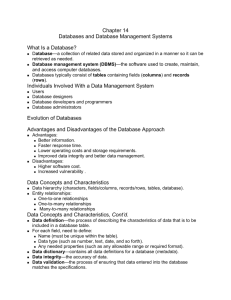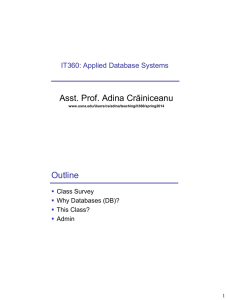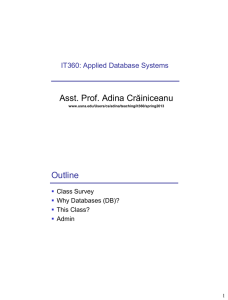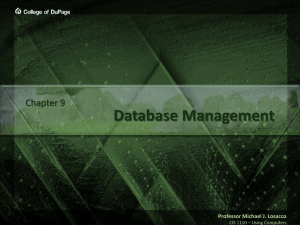Chapter 10 Database Management
advertisement
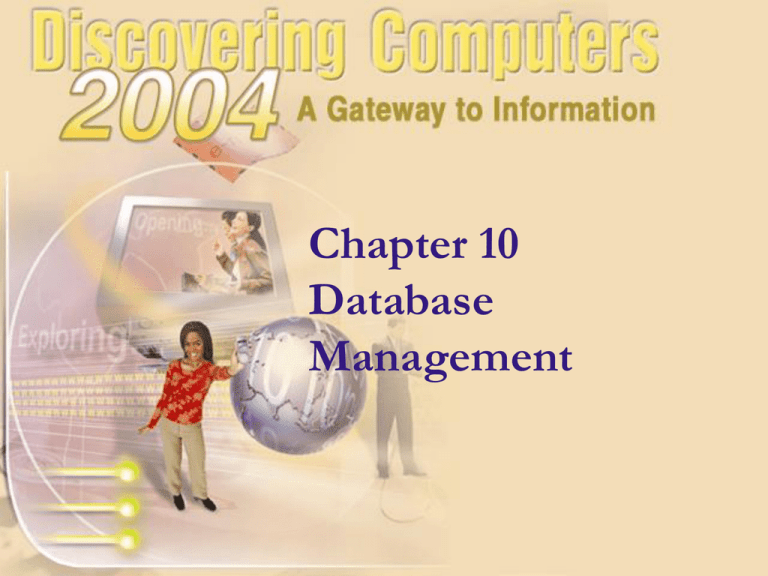
Chapter 10 Database Management “If you want to leave footprints in the sands of time, don’t drag your feet.” Data vs. Information Data - raw facts Information - processed data Data integrity- accuracy of data Data security - protecting data Data and Information What is data integrity? Degree to which data is correct Garbage in, garbage out (GIGO)—computer phrase that means you cannot create correct information from incorrect data Garbage in Garbage out Data integrity is lost p. 10.03 Next Data and Information What is a database? Collection of data organized so you can access, retrieve, and use it Database software allows you to Create database Click to view animation p. 10.03 Database software also called database management system (DBMS) Add, change, and delete data Sort and retrieve data Create forms and reports Next Data and Information What are the qualities of valuable information? Accurate Verifiable Timely Organized Accessible Useful Cost-effective p. 10.04 Next Hierarchy of Data Bit - one binary digit Byte - eight bits Field - one or more characters (name, ssno) Record - collection of related fields File - collection of related records Database - collection of related files The Hierarchy of Data records p. 10.07 Member ID First Name Last Name Address City State 2295 Donna Vandenberg 1029 Wolf Avenue Montgomery AL 2928 Shannon Murray 33099 Clark Street Montgomery AL 3376 Adrian Valesquez 15 Duluth Street Prattville AL 3928 Jonah Weinberg P.O. Box 45 Clanton AL 4872 Marcus Green 22 Fifth Avenue Auburn AL key field fields Next Maintaining Data What is file maintenance? Procedures that keep data current Adding records Changing records Deleting records p. 10.08 Next Maintaining Data What is validation? Process of comparing data with a set of rules to find out if data is correct Reduce data entry errors and enhance data integrity before program writes data on disk p. 10.10 Fig. 10-8 SAMPLE VALID AND INVALID DATA Validity Check Field Being Checked Valid Data Invalid Data Alphabetic Check First Name Adrian Ad33n Numeric Check Postal Code 36109 3rto9 Range Check Monthly Fee $39.50 Consistency Check Date Joined Training Date Last Name Completeness Check $95.25 10-20-2004 10-20-2004 10-27-2004 10-13-2004 Valesquez Next File processing vs. databases File processing system (flat files) data redundancy isolated data File Processing Versus Databases What is the database approach? Many programs and users can share data in database Secures data so only authorized users can access certain data p. 10.12 Fig. 10-9 Next File Processing Versus Databases What are the strengths of the database approach? Reduced data redundancy Improved data integrity Shared data Easier access p. 10.13 Reduced development time Next Database Management Systems What are popular database management systems (DBMSs)? Click to view Web Link, then click Database Management System below Chapter 10 p. 10.14 Database Manufacturer Computer Type Access Microsoft Corporation Personal computer, server, PDA DB2 IBM Corporation Personal computer, midrange server, mainframe Informix IBM Corporation Personal computer, midrange server, mainframe Ingres Computer Associates International, Inc. Personal computer, midrange server, mainframe Oracle Oracle Corporation SQL Server Microsoft Corporation Personal computer, midrange server, mainframe, PDA Server Sybase Sybase Inc. Personal computer, midrange server, PDA Next DBMS Data Base Management System (DBMS) set of programs designed to control access to the database and manage the data Data dictionary Data maintenance and retrieval - query language Data security Backup and recovery Database Management Systems What is a data dictionary? Contains data about each file in database and each field within those files Click to view Web Link, then click Data Dictionary below Chapter 10 p. 10.14 Fig. 10-12 Next Database Management Systems Step 1. Select the fields you want What is a query? Request for specific data from a database Query language consists of simple, English-like statements that allow users to specify data to display, print, or store to display in the resulting query. Step 2. Assign a name to the query, so you can open it later. Step 3. View query on the screen. p. 10.16 Fig. 10-13 Next Database Management Systems What is data security? Access privileges define activities that specific user or group of users can perform DBMS provides means to ensure only authorized users can access data Read-only privileges user can view data, but cannot change it p. 10.18 Full-update privileges user can view and change data Next Types of Databases Relational database - links files through the use of a common field Object-oriented database - database based on an object-oriented model. Can store more types of data and access it faster (photos, video clips) Databases cont. Hierarchial database - (tree structure) - organized like a family tree - each parent can have more than one child, but each child may have only one parent Network database - Like an hierarchial database except that each child may have more than one parent Multidimensional Database – Stores data in dimensions (can store more than two dimensions – ex. Storing text and video clips) Relational, Object-Oriented, and Multidimensional Databases What is a relational database? Stores data in tables that consist of rows and columns Each row has primary key Each column has unique name Stores data relationships Uses specialized terminology DATA TERMINOLOGY Click to view Web Link, then click Relational Databases below Chapter 10 p. 10.20 Fig. 10-19 Next Relational, Object-Oriented, and Multidimensional Databases What is a relationship? Connection within data Click to view animation p. 10.21 Fig. 10-20 Next Relational, Object-Oriented, and Multidimensional Databases What is an object-oriented database (OODB)? Stores data in objects Advantages Object is item that contains data, as well as actions that read or process data Can store more types of data Can access data faster Often uses object query language (OQL) Click to view Web Link, then click Object-Oriented Databases below Chapter 10 p. 10.22 Next Relational, Object-Oriented, and Multidimensional Databases What is a multidimensional database? Stores data in dimensions Multiple dimensions, also called hypercube, allow users to analyze any view of data Can consolidate data much faster than relational database Click to view Web Link, then click Multidimensional Databases below Chapter 10 p. 10.23 Next Web Databases What is a Web database? Database you access through the Web by filling in a form on a Web page Usually resides on a database server, a computer that stores and provides access to a database Click to view video p. 10.24 Fig. 10-23 Next Database Administration What is the role of the database analyst and administrator? Database analyst (DA) Focuses on meaning and usage of data Decides proper placement of fields, defines relationships, and identifies users’ access privileges Database administrator (DBA) Creates and maintains data dictionary, manages database security, monitors database performance, and checks backup and recovery procedures Click to view Web Link, then click Database Administrators below Chapter 10 p. 10.27 Next That’s all folks
